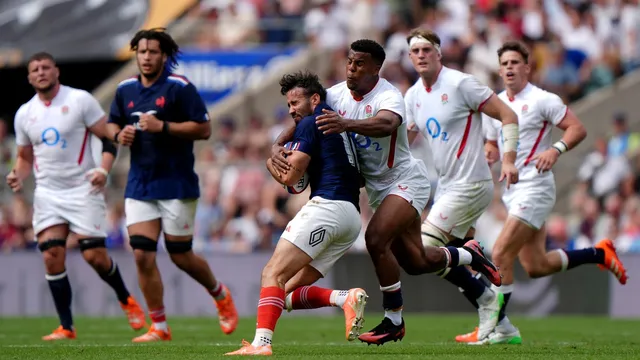
Immanuel Feyi-Waboso's red card costs England in close match against France
2025-06-23 15:55- Immanuel Feyi-Waboso was sent off for a high tackle during the match against France.
- England held a 12-point lead with just ten minutes remaining but lost the game after conceding two late tries.
- The defeat raises concerns about discipline and cohesion as the team prepares for the tour of Argentina.
Express your sentiment!
Insights
England's rugby team faced a disappointing defeat against France in a non-capped match that took place at Allianz Stadium, Twickenham. The match was significant for returning winger Immanuel Feyi-Waboso, who had not played since dislocating his shoulder in December. Sadly, he was sent off in the first half after a high tackle on French fly-half Antoine Hastoy, an act that deeply affected the team's performance. Despite England leading by 12 points with only ten minutes left, the match turned dramatically in the final moments. As England appeared to be on the verge of victory, France capitalized on late-game indiscipline from the English side, scoring two converted tries in quick succession. The shift in momentum emphasized England's lack of composure under pressure and their inability to maintain their advantage. Although several English players had performed well, notably scoring four tries throughout the match, the late flurry of points by France ultimately sealed their triumph. Head coach Steve Borthwick had high hopes for the match, especially with Feyi-Waboso returning from injury. However, the red card not only impacted the game's outcome but also complicated England's plans for the upcoming tour to Argentina. Feyi-Waboso faces a two-match suspension, meaning he will miss the Argentina matches but may still join the squad for the Test against the USA later. With Feyi-Waboso out of contention for the important upcoming series, the team now must refocus and adjust strategically without one of their key players. The match against France served as a stark reminder of the pressures and challenges of international rugby, particularly in preparation for a critical summer tour where team cohesion and discipline will be paramount. This encounter highlighted the importance of maintaining composure in tight matches and the need for the team to learn from their mistakes moving forward.
Contexts
The impact of high tackle penalties in rugby matches is a significant topic that has garnered attention from players, officials, and fans alike. High tackles, which are those that occur above the line of the shoulders, pose serious risks to player safety and are closely regulated to minimize injuries, particularly concussions. The introduction of stringent penalties for high tackles serves not only to protect players but also to uphold the integrity of the sport. This regulatory framework has led to an increase in the number of penalties awarded during matches, which in turn affects the flow of the game, team strategies, and overall match outcomes. Statistical analysis indicates that the frequency of high tackle penalties has increased over recent years, reflecting an evolving understanding of player safety and a commitment to reducing the incidence of head injuries. While some critics argue that this emphasis on penalties can lead to disruptions in gameplay and a more fragmented match experience, supporters maintain that the long-term benefits for player well-being outweigh these concerns. Teams face the challenge of adapting their defensive strategies to minimize penalties and protect their players while still competing effectively under the constraints of these rules. Moreover, the impact of high tackle penalties extends beyond individual matches to influence broader team performance across the season. Teams that consistently receive penalties for high tackles may find themselves at a disadvantage due to the cumulative effects of playing with reduced numbers, as well as the mental toll of facing a sanction-heavy environment. The data suggests that the correlation between a high number of penalties and match losses is significant, as teams that manage to limit these infractions tend to achieve better results. This creates a clear incentive for coaches and players to prioritize training methods focused on safe tackling techniques, which may also enhance overall gameplay. In conclusion, the implementation of high tackle penalties in rugby serves as a crucial mechanism for ensuring player safety in a contact sport. While there are challenges associated with these regulations, they ultimately encourage the development of safer playing techniques, adapted strategies, and a culture that prioritizes the health of the athlete. The continuous monitoring of these penalties' effects on match dynamics is essential for informed decision-making by governing bodies and can contribute to a safer future in rugby.